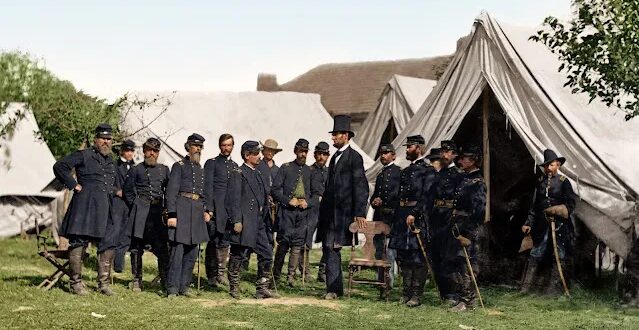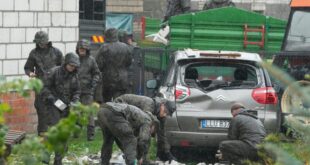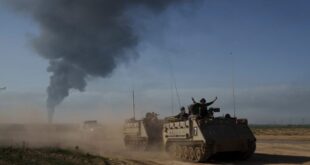The Object of War
From the moment in early April when Russian forces on the perimeter of Kiev began to withdraw to new positions in eastern Ukraine, western war propagandists have been trumpeting what they characterized as Russia’s “humiliating defeat”. As one who recognized as early as February 28th that the Russian army was executing a strategic feint in and around the Ukrainian capital, I could only shake my head and laugh at the cluelessness of most of the so-called “experts” who have attempted to sell this interpretation of events to hopelessly ignorant western audiences.
I am reminded of how, during the US Civil War, Abraham Lincoln was ceaselessly frustrated with his early cadre of generals.
Much as the vast majority of current western military “experts” have been fixated on conquering “territory” as a measure of progress, or the lack thereof, Lincoln’s early generals were illogically focused on the objective of “taking Richmond” – the capital of the Confederacy. This obsession dominated the strategic focus of the Union high command for most of the war.
Lincoln, on the other hand – notwithstanding there is no evidence he ever read von Clausewitz – intuitively and correctly understood that it was not a city, nor any piece of territory, per se, that was the objective upon which his West Point-trained generals should focus.
Rather, he repeatedly (and vainly) urged his generals to come to understand it was the destruction of the Confederate Army of Northern Virginia, commanded by General Robert E. Lee, that constituted the only valid objective of their actions.
Lincoln’s frustration with this lack of understanding on the part of his generals reached its zenith after the July 1863 Battle of Gettysburg when, despite having Lee’s defeated and demoralized army trapped on the north side of the Potomac River, Union General George Meade permitted it to escape.
Lincoln was beside himself when he learned Lee had effected a crossing of the river with all his troops, and was able to regroup once again.
Fortunately, in March 1864 Lincoln finally found the general he had been looking for: Ulysses S. Grant.
Destroying the Enemy Army
Grant was given supreme command of the Union armies, and from that point until the end of the war he made his sole objective the engagement and destruction of Lee’s army.
The subsequent series of battles became known as the Overland Campaign, with both armies maneuvering southward from one bloody engagement to the next. Grant made several tactical errors and suffered inordinate casualties on multiple occasions. He could have even finally “taken Richmond”, and thereby secured a strategically meaningless “victory”, but he ignored the opportunity to do so.
Grant’s focus never varied from its singular objective: to destroy the enemy army. He sought every chance to engage it. If he lost a particular battle, he simply disengaged momentarily, and then moved to flank the Confederates yet again, forcing another engagement of forces.
This relentless series of battles and maneuvers finally culminated in Lee’s army seeking refuge in a massive complex of field fortifications and earthworks outside Petersburg, Virginia. From that point, highly accurate Union rifled artillery systematically ripped them to pieces for months, ultimately forcing Lee’s surrender, and the end of the war.
The “Demilitarization” of Ukraine
This has been precisely the Russian mentality in Ukraine. Their foremost objective, from the very beginning, as explicitly articulated by President Vladimir Putin in his historic speech of February 24, 2022, was to “demilitarize” Ukraine – to destroy its army.
When the war began, the most capable, experienced, well-armed, and well-positioned Ukrainian forces were NOT in Kiev, but in the Donbass and Mariupol. They had been positioning there for months, with the ultimate objective of retaking the Donbass and Crimea – a goal never far from the minds of Ukraine’s ideological and political leaders.
Indeed, they spoke of it openly and without qualification. They strongly believed the strength of their armed forces, after eight years of preparation, had reached a point where it was capable of actually achieving that objective.
Their benefactors in NATO encouraged them to believe this – for it was also NATO’s fondest dream to raise its banners over the naval base at Sevastopol, and thereby wield dominance over the entire Black Sea and the Bosporus.
Pursuant to this and many other geostrategic objectives – arresting Russian resurgence foremost among them – NATO had been providing arms to Ukraine for years, and those arms shipments were expanded and accelerated dramatically in late 2021.
Tens of thousands Ukrainian troops had been trained in the use of these NATO armaments. And, as was known to anybody paying even casual attention, thousands of western intelligence operatives, special forces, and mercenary contractors (predominantly American, British, and French – and lots of them) were embedded with front-line Ukrainian forces, where several have since been killed or captured, and a substantial contingent still remains.
Many of these western troops are there primarily to coordinate the reception, interpretation, and “actionable” use of highly prized and even more highly classified US/NATO “ISR” (Intelligence, Surveillance & Reconnaissance) data.
The Mother of All Proxy Armies
The army the US/NATO built in Ukraine, by the beginning of 2022, had swelled to become the largest and best-armed land force in Europe. By almost every metric, it was more potent than the combined armies of Germany, France, and Italy.
The Ukrainian military was purpose-built to serve the interests of the American Empire in its long-established goal to cripple Russia and prevent it from ever again being able to wield global influence; to effect its ultimate dismemberment and reduce it to a faint fragment of its former status and glory – to realize the geopolitical objective expressed in the popular cold-war-era board game RISK, which erased Russia from the world map.
The Russian decision to invade Ukraine in late February 2022 was motivated by and predicated upon all of these factors in aggregate, and was hastened by the widespread Ukrainian artillery strikes on the Donbass region that had commenced weeks previously.
To destroy this powerful “Mother of All Proxy Armies” which the United States and its NATO partners had methodically constructed on its borders was, logically and manifestly, Russia’s foremost objective.
There was no other.
The elimination of this substantial threat on their literal doorstep was understandably viewed by the Russians as an existential imperative.
Destroying the Mother of All Proxy Armies
And, in order to best achieve that objective, they effected a classic Russian stratagem to impede the possibility of the forces in northern Ukraine from reinforcing those in eastern and southern Ukraine once the fighting began.
THIS is why they conducted the elaborate “feint and fix” operation in and around Kiev.
And, all things considered, it worked perfectly.
That said, it is essential to understand that the greatest and most effective feints must be convincing. And, to be convincing, they very often risk being costly. The best feints are based on a cost/benefit analysis whose “benefit” often represents the foremost objective of a war.
In the case of the feint and fix operation in Kiev, there was a substantial cost – although it was not nearly as costly as western war propagandists have sought to portray it. This is because much of the feint consisted of demonstrations of intent, rather than concrete actions.
For example, after achieving air dominance in the first few days of the war, the Russians assembled a huge armored column, and casually drove it down the main highway from the north towards Kiev. Then they essentially just parked it there for many days, occasionally pretending to be heading in one direction or another, before eventually pulling back to their own borders, and sweeping around to join the forces preparing to launch the main offensive in the Donbass.
Everything it did north of Kiev was all for show. They didn’t break down; their troops didn’t run away; they didn’t run out of gas. It was just a big “feint-in-force”.
Even Belarus assisted in the theatrics by assembling troops and vehicles, moving them around aggressively just across the border from Ukraine, and making veiled threats to join the Russian assault on Kiev – which, of course, they never did, because no such assault was ever envisioned. And these aggressive Belarusian demonstrations ceased once the Russians concluded the feint operation and moved their forces to the southeast.
The result of this feint operation was that, over the course of several weeks, the Russians effectively “fixed” over 100,000 Ukrainian troops and their equipment in the vicinity of Kiev, took control of key transportation nodes and corridors between Kiev and the Donbass, and simultaneously conducted a major offensive to encircle and annihilate the 20,000-strong Ukrainian army group in Mariupol, a highly strategic port city on the coast of the Sea of Azov.
The forces in Mariupol included the notorious neo-Nazi “Azov Battalion”, whose arming and training had long been a US/NATO priority, and they were considered to be one of the most formidable components of the Ukrainian army.
The forces in Mariupol also included many dozens of NATO “advisors” (CIA, special forces, and so-called “contractors”). Also present were ~2500 foreign mercenaries, most of them NATO veterans of the wars in Iraq and Afghanistan.
While potential reinforcements remained idle and immobile in and around Kiev, the powerful force in Mariupol was methodically surrounded and systematically annihilated in an operation I am confident will be studied in war colleges for generations as one of the most impressive prosecutions of urban warfare ever executed.
The Russians completely reversed the generally accepted casualty ratio between attacker and defender, and did so against an enemy shielded within massive and complex fortifications it had prepared for years inside the sprawling Azovstal steel plant.
While all of this was taking place, Russian forces and their allies from the Donetsk and Lugansk republics engaged in “shaping the battlefield” in the Donbass region in anticipation of the next and most important stage of the war.
Bear in mind, the Ukrainian forces in the Donbass had spent eight long years building an elaborate series of hardened fortifications in the region with the objective of resisting a Russian attack and inflicting severe damage upon them when they did.
Of course, the Russians knew all this, and they clearly planned out a course of action designed to overcome the advantages that accrued to the Ukrainians as a result of their fortifications and their reprehensible tactics of using civilians and their dwellings as shields.
As matters stand here in early July, it is now incontrovertible that the Russian operation in the Donbass has been an overwhelming victory. It is, in my estimation, the most impressive management of a quasi-urban battlefield in modern history. The original force, consisting of over 60,000 of the best-trained and best-equipped soldiers in the Ukrainian army, has been effectively destroyed. It has suffered catastrophic losses of its experienced, NATO-trained professional cadres. Its massive losses of personnel have been partially replenished by poorly trained territorial militia troops, but its even more massive losses of heavy weaponry cannot be replenished.
I described the Russian strategy and tactics in a previous post:
Here is a brief summation of the Russian tactical approach to the Battle of the Donbass:
Step #1: Advance reconnaissance units (often in force, with dozens or hundreds of drones overhead) to assess the situation; draw fire; relay to commanders raw video and geo-coordinates.
Step #2: With target-correcting drone swarms overhead, relaying real-time strike video, proceed to savage the fortifications with towed and mobile artillery, Multiple Launch Rocket Systems (in gradations of strength and precision), and even horrific thermobaric munitions for particularly suitable targets.
Let smoke clear.
Repeat Step #1.
Still something moving there?
Repeat Step #2.
Repeat Step #1.
Dead bodies everywhere?
Step #3: Send in tanks and infantry to mop up.
Move to next series of fortifications.
And so on and so forth …This is why Ukraine now suffers hundreds of battle deaths every single day. And why, for months, the Russians have suffered very few casualties – at least a 1 to 10 ratio – and quite likely much lower.
The artillery (with occasional air and precision missile strikes) is doing all the fighting.
The Russian objective was NEVER to “take Kiev”. I’ve heard all the arguments and rationalizations to the contrary. They are demonstrably fallacious. The foremost Russian objective was ALWAYS to destroy the Ukrainian army, the most potent groupings of which were positioned in the Donbass and in Mariupol. And they have done so COMPREHENSIVELY.
I am likewise persuaded that “demilitarization” will continue to be the Russian objective in Ukraine until the Ukrainians beg to surrender, accepting whatever terms the Russians propose.
Only then will the disposition of territory be decided once and for all, and if the map includes at all a toponym for a sovereign Ukraine, it will likely look somewhat like this:
We can only hope desperate #EmpireAtAllCosts fanatics in London and Washington don’t commit a fatal blunder in their futile attempts to retain hegemony in the face of a resurgent multipolar world.
 Eurasia Press & News
Eurasia Press & News




